
Facebook Twitter Instagram YouTube
Written on: October 23rd, 2015 in Living Shorelines
A “Living Shoreline” is a method of bank stabilization that reinforces the shoreline to protect coastal properties from erosion, while also restoring and enhancing fish, wildlife water quality and wetland habitat. Unlike bulkheads and stone riprap, living shorelines use natural materials to maintain existing connections between the shoreline and aquatic areas. A number of living shoreline materials and tactics are available, including coconut fiber coir logs, natural fiber matting, recycled shell, and native wetland vegetation.
Living shorelines have been built throughout Delaware’s coastal regions and are a popular option for bank stabilization because they protect property from erosion while attracting fish and shellfish, filtering polluted runoff, and absorbing wave energy during storms.
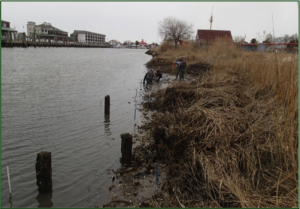
This restoration site was constructed to address an undercut and deteriorating existing salt marsh shoreline. The site is exposed to low energy for the majority of the time with peaks of energy from boats launching from the opposite shoreline. The site has low energy, so standard vegetated living shoreline tactics were selected. Shorelines subject to high wave energy may require marsh sills or offshore breakwaters but should only be used when necessary.
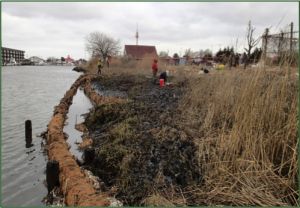
The slope of the eroding shoreline required two tiers of coconut fiber logs staked on top of each other to reach the optimal elevation for Spartina grass. The first round of coconut fiber matting and logs were positioned in the intertidal zone before being staked down and tied in place. Oyster shell bags were then arranged in front of the coir logs to further armor the shoreline and absorb wave energy. The next step was to allow sediment to fall out of the naturally turbid water into the cells created by the coconut fiber logs.
This Living Shoreline project was installed on April 14-17, 2014. After 6 months enough sediment had built up inside the shoreline that the second tier of coconut fiber logs were installed on October 20, 2014. The second tier of logs allowed sediment to continue to accumulate and raise the elevation to the optimal growing elevation for Smooth Cordgrass. The site was planted in March/April 2015 with Smooth Cordgrass. Spring planting allowed vegetation to take root throughout the growing season before winter storms.
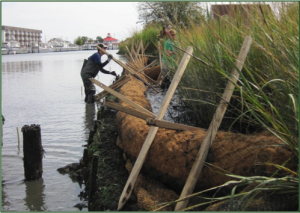
Living Shorelines may need augmentation over the years. However, successful projects throughout the Mid-Atlantic have survived multiple hurricanes!
This project was collaboration between Delaware Department of Natural Resources, Partnership for the Delaware Estuary and Delaware Center for the Inland Bays.
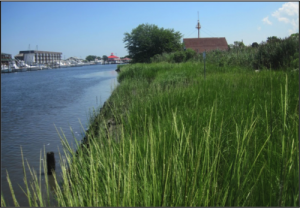
Written on: October 23rd, 2015 in Living Shorelines
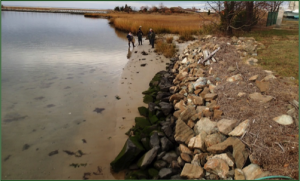
A “Living Shoreline” is a method of bank stabilization that reinforces the shoreline to protect coastal properties from erosion, while also restoring and enhancing fish and wildlife habitat. Unlike bulkheads and revetments, living shorelines use natural materials to maintain existing connections between the shoreline and aquatic areas. A number of living shoreline materials and tactics are available, including coconut fiber logs, recycled shell, and native wetland vegetation. Living shorelines have been built throughout coastal regions and are a popular option for bank stabilization because they protect property from erosion while attracting fish and shellfish, filtering stormwater, and absorbing wave energy during storms.
Two uniquely different shorelines were restored at the Indian River Marina in Rehoboth Beach, DE. The “marsh” restoration site was constructed to address an undercut and deteriorating existing salt marsh shoreline. The “rip rap” restoration site was built along a sandy shoreline as an option for “greening-up” an existing rip rap structure. Both sites are exposed to low wave energy, so standard vegetated living shoreline tactics were selected. Shorelines subject to high wave energy may require marsh sills or offshore breakwaters but should only be used when necessary.
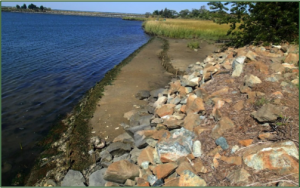
Coconut fiber matting and logs were positioned in the intertidal zone before being staked down tied in place. Oyster shell bags were then arranged in front of the coir logs to further armor the shoreline and absorb wave energy. Following installation, clean sand fill was brought to the restoration sites and graded to the desired elevation and slope before planting with Smooth Cordgrass (Spartina alterniflora).
Both living shoreline projects were installed on April 14-17, 2014. While many shorelines will naturally collect sediment, after 2 months of monitoring this area approximately 45 yd3 of clean sand was used to grade the shorelines to the optimal growing elevation for Smooth Cordgrass. Sites were be planted in March 2015 with Smooth Cordgrass. Spring planting allows vegetation to take root throughout the growing season before winter storms.
Living shorelines may need slight augmentation over the years. However, successful projects throughout the Mid-Atlantic have survived multiple hurricanes!
This project was collaboration between Delaware Department of Natural Resources, Partnership for the Delaware Estuary and Delaware Center for the Inland Bays.
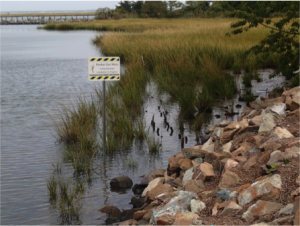
Written on: October 23rd, 2015 in Living Shorelines
A “living shoreline” is a technique used to either protect or restore a shoreline, and is built using natural materials and native plants to mimic native coastal habitats. Natural materials used in living shorelines include: sand, coconut-fiber logs coir logs and mats, oyster shell bags, live mussels and plants. Living shorelines protect the shoreline from erosion and defend our coasts from damaging storm wave energy, all the while encouraging native plants and wildlife.
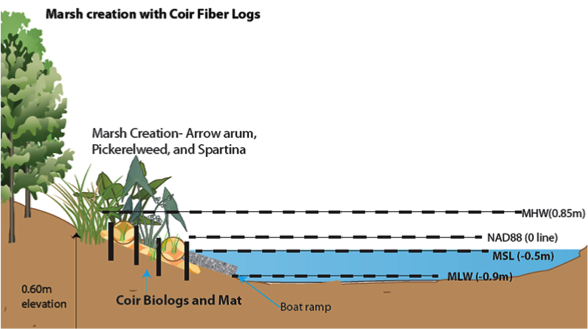
In the case of the Blackbird Creek Reserve living shoreline sites, the shoreline on either side of the kayak ramp was shifting and washing away due, in part, to quick moving river currents (Figure 2.). To prevent further erosion, or loss, of the shoreline and to protect the adjacent habitat, two living shorelines were installed in early May of 2015.
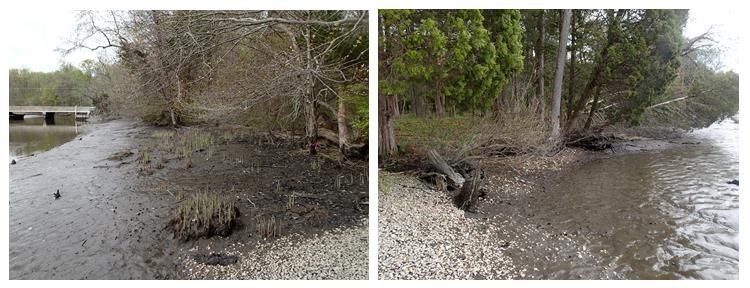
This project began by placing a series of coir logs, sand, dirt and wooden stakes along the bank to increase the height of the bank above the water level. These logs were placed on mats to stop them from sinking in the mud, and then staked in to keep them from moving. Coir logs act as temporary fences to hold soil in place and also trap sediments floating in the water column, giving plants a great habitat to grow. The West side location already had a native wetland plant, arrow arum, growing, but the east side location on the other side of the ramp was empty so clean sand was trucked in and topped with a little soil to create a nice high base (Figure 3.).
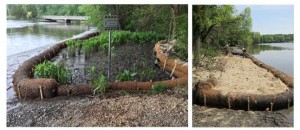
Once the mats, logs and sand were in place, a few weeks passed by to allow things to settle. In June of 2015, a variety of native plants (arrow arum, smooth cordgrass, pickerelweed, saltmarsh bulrush, yellow sneezeweed, swamp rose, marsh hibiscus, New York ironweed and pin oak) were planted in the projects. Once these plants start to grow, they will help further trap sediments, stabilize the bank and completely cover the coir log structures.
The site is regularly monitored to track progress, and is a collaboration between Delaware’s Natural Resources and Environmental Controls (DNREC) Wetland Monitoring and Assessment Program (WMAP), the Delaware National Estuarine Reserve (DNERR) and the Division of Fish and Wildlife.